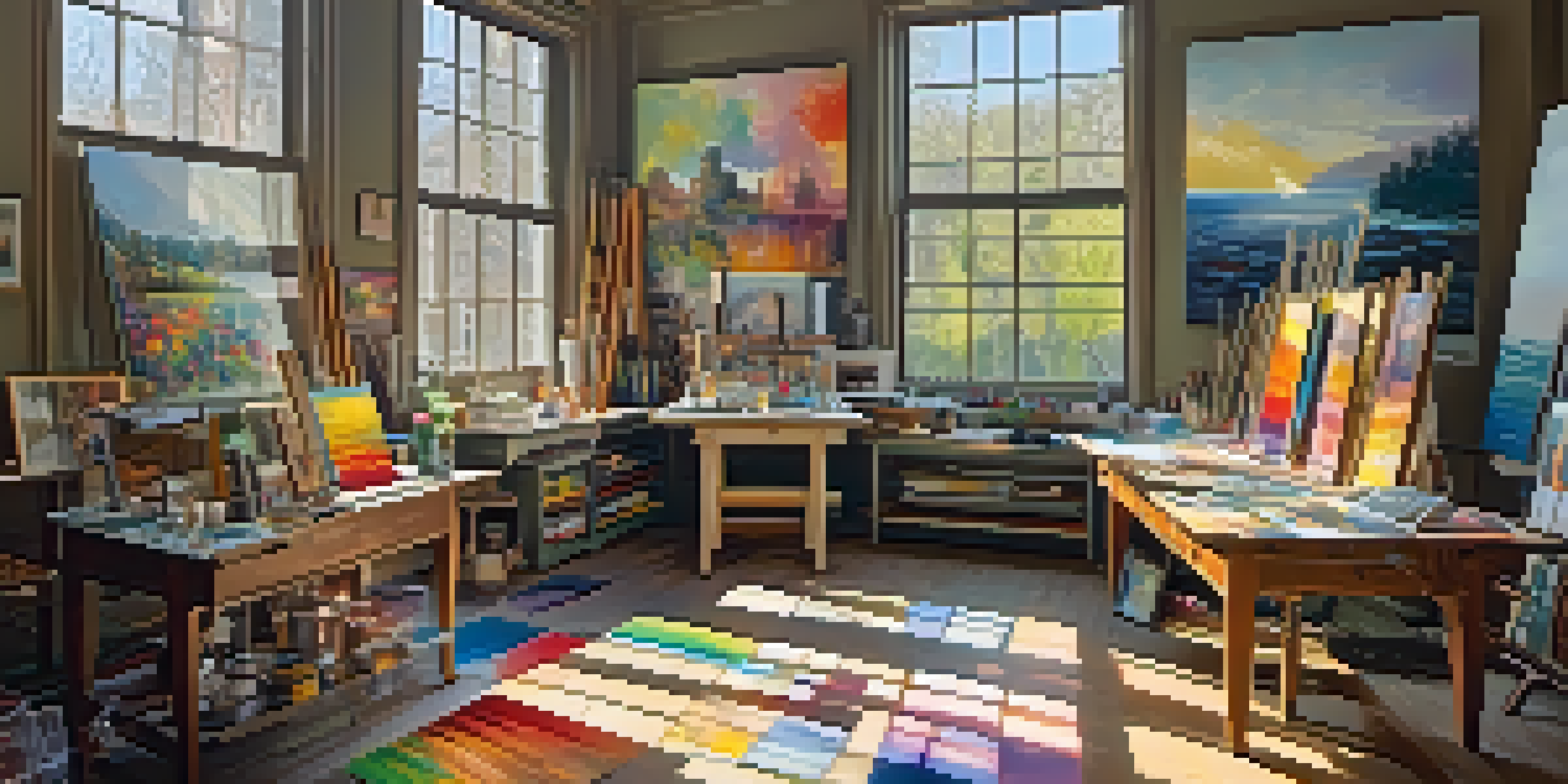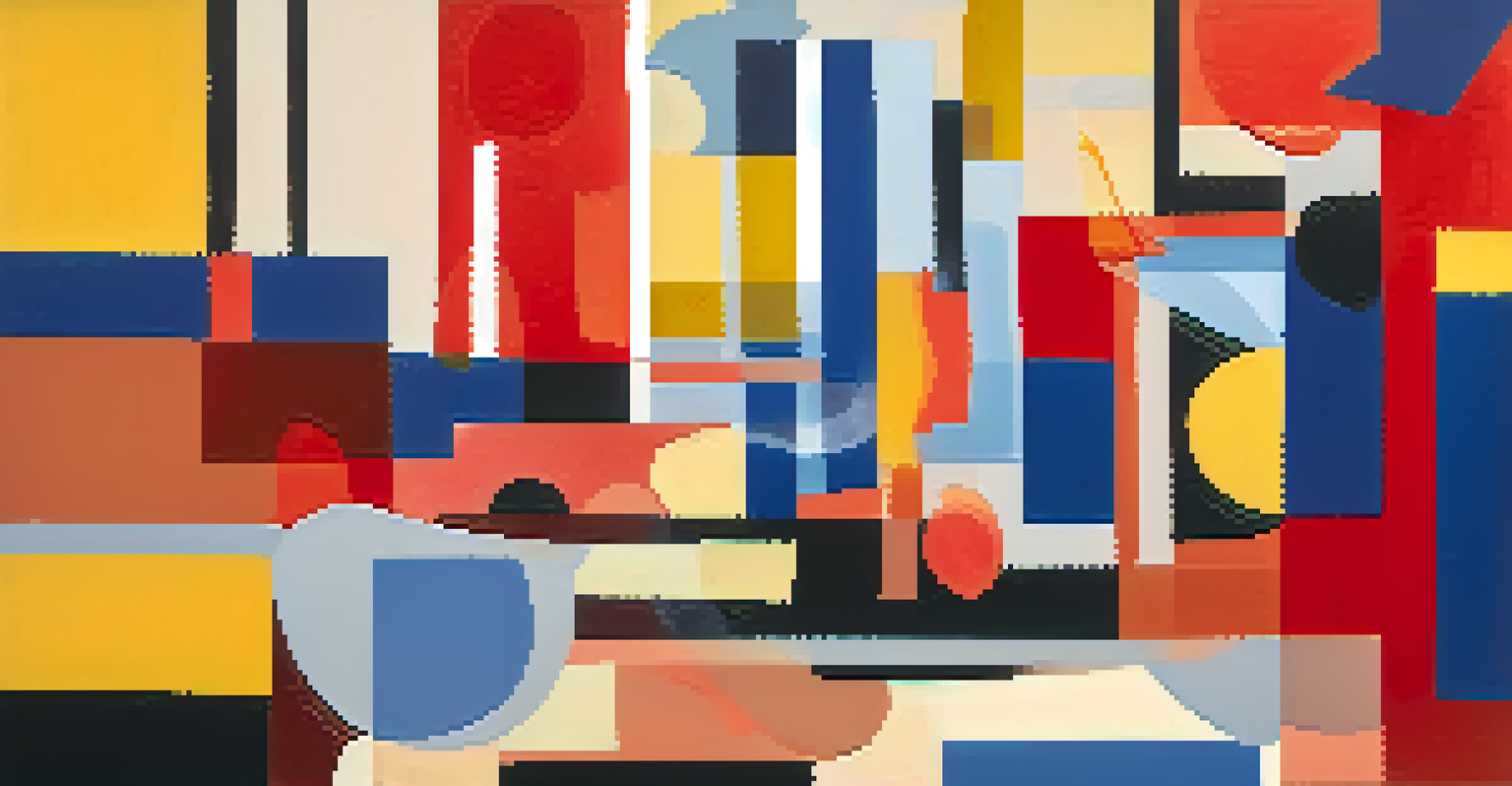The Influence of Painters on Graphic Designers' Work

Understanding the Connection Between Painting and Design
At first glance, painting and graphic design might seem worlds apart, but they share a deep-rooted connection. Both disciplines are fundamentally about visual communication, using color, composition, and form to convey messages. Just as painters evoke emotions through their brushstrokes, graphic designers aim to create engaging visuals that resonate with their audience.
Color is the keyboard, the eyes are the harmonies, the soul is the piano with many strings.
Painters often experiment with techniques and styles that can inspire graphic designers. For example, the bold colors of expressionism might lead a designer to adopt a more vibrant palette in their work. Ultimately, this shared language of visual arts allows designers to draw on the rich history of painting to enrich their own creations.
By understanding the techniques and intentions behind famous painters' works, graphic designers can elevate their designs. This cross-pollination of ideas helps create a more dynamic and innovative approach to visual storytelling.
Color Theory: Lessons from Famous Painters
Color theory is a vital aspect of both painting and graphic design, influencing how we perceive and react to visuals. Artists like Vincent van Gogh and Claude Monet have demonstrated the emotional power of color, using it to create mood and atmosphere. Graphic designers can benefit immensely from studying these painters' approaches to color application.

For instance, van Gogh's use of contrasting colors to express emotions can teach designers how to evoke similar responses in their audience through thoughtful color choices. By analyzing the color palettes of these masters, designers can develop their own unique styles while also grounding their work in proven techniques.
Visual Communication Unites Art Forms
Painting and graphic design share a fundamental connection through their use of color, composition, and form to convey messages.
Ultimately, understanding color theory through the lens of painting helps designers create more compelling visuals that not only attract attention but also communicate their intended messages effectively.
Composition Techniques Borrowed from Painters
Composition is another critical element that graphic designers can learn from painters. The way painters arrange elements on a canvas can provide valuable insights into creating balance and harmony in design. For example, the rule of thirds, commonly used in both fields, guides designers in placing focal points strategically.
Design is where science and art break even.
By studying the compositions of artists like Leonardo da Vinci or Piet Mondrian, graphic designers can gain inspiration for their own layouts. Da Vinci's mastery of symmetry and proportion can inform a designer's approach to creating harmonious designs, while Mondrian's abstract grids can inspire innovative layouts.
These compositional techniques help designers create visually appealing work that captures attention and maintains viewer interest, proving that the lessons from painters are timeless and relevant.
Typography: Artistic Influence from the Canvas
Typography plays a crucial role in graphic design, much like the choice of brush and paint in a painter's toolkit. While painters focus on visual storytelling through imagery, graphic designers use typography to convey messages and create brand identity. The artistic flair seen in some paintings can inspire designers to approach typography creatively.
For example, the expressive brushwork of artists like Jackson Pollock can inspire designers to develop custom typefaces that reflect a similar energy and spontaneity. By embracing the artistic aspects of typography, designers can create unique visual experiences that stand out.
Color Theory Enhances Design Impact
Studying the color techniques of renowned painters helps graphic designers evoke emotions and create compelling visuals.
Furthermore, understanding the historical context of typography's evolution, influenced by artistic movements like Art Nouveau or Bauhaus, helps designers appreciate the art form's depth and versatility.
Emotional Impact: Drawing from the Painter's Palette
One of the most profound influences painters have on graphic designers is the emotional impact of their work. Painters often aim to evoke feelings through their art, and this principle can be applied to graphic design as well. Designers can learn to create visuals that resonate emotionally with their audience by analyzing how painters achieve this.
For instance, the melancholic tones of Edvard Munch's 'The Scream' can inspire designers to choose imagery and colors that reflect similar emotions. By understanding the emotional triggers in a painting, designers can create visuals that evoke specific feelings, whether it be joy, nostalgia, or urgency.
This emotional connection not only enhances the viewer's experience but also strengthens the overall effectiveness of the design.
Cultural Influence: Painters as Sources of Inspiration
Painters are often influenced by their cultural backgrounds, and this influence can extend to graphic designers as well. By exploring different artistic movements, such as the Mexican muralists or the Japanese ukiyo-e artists, designers can draw inspiration from diverse cultural perspectives. This can lead to richer, more inclusive designs that resonate with a broader audience.
For example, the vibrant colors and intricate patterns found in traditional African art can inspire graphic designers to incorporate similar elements into their work, creating visuals that celebrate cultural heritage. By embracing these influences, designers can create compelling narratives that honor and reflect the diversity of human experience.
Cultural Inspirations Enrich Design
Drawing from diverse cultural influences allows graphic designers to create inclusive and innovative visuals that resonate with wider audiences.
Incorporating cultural elements can also lead to innovative design solutions and help break the monotony often seen in contemporary graphics.
Innovative Techniques: The Evolution of Graphic Design
As graphic design evolves, so does the influence of painting on its techniques and processes. Digital tools now allow designers to experiment with styles reminiscent of famous painters, creating a fusion of traditional and modern art forms. Techniques like brushstroke effects or layering can mimic the texture and depth of paintings, resulting in unique visual experiences.
For instance, designers can use software to create digital collages that resemble the cut-out style of Henri Matisse, blending various elements to form a cohesive design. This innovative approach opens up new avenues for creativity and expression, pushing the boundaries of what graphic design can achieve.

Ultimately, the marriage of painting techniques and graphic design not only enriches the aesthetic quality of work but also encourages designers to think outside the box.